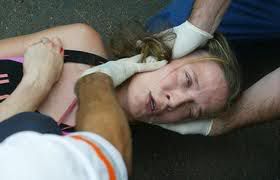Seizures are paroxysmal motor, sensory, or cognitive manifestations of spontaneous, abnormally synchronous electrical discharges from collections of neurons in the cerebral cortex. Seizures are thought to result directly or indirectly from changes in excitability of single neurons or groups of neurons.
The site of seizures generation and the extent to which the abnormal neural activity is conducted to other areas of the brain determine the type and manifestations of the seizures activity.
Partial seizures originate in a small group of neurons in one hemisphere with secondary spread of seizures activity to other parts of the brain. Simple partial seizures usually are confined to one hemisphere and do not involve loss of consciousness. Complex partial seizures begin in a localized area, spread to both hemispheres, and involve impairment of consciousness.
Generalized seizures show simultaneous disruption of normal brain activity in both hemispheres from the onset. They include unconsciousness and varying bilateral degrees of symmetric motor responses with evidence of localization to one hemisphere. Absence seizures are generalized non-convulsive seizures events that are expressed mainly by brief periods of unconsciousness. Tonic-clonic seizures involve unconsciousness along with both tonic and clonic muscle contractions.
Classification of Epileptic Seizures
Seizures are caused by spontaneous, uncontrolled, paroxysmal, transitory discharges from cortical centers in the brain. Seizures may occur as a reversible symptom of another disease condition or as a recurrent condition called epilepsy. Epileptic seizures are classified as partial or generalized seizures. Partial seizures have evidence of local onset, beginning in one hemisphere. They include simple partial seizures, in which consciousness is not lost, and complex partial seizures, which begin in one hemisphere but progress to involve both. Generalized seizures involved both hemispheres and include unconsciousness and rapidly occurring, widespread, bilateral symmetric motor responses. They include minor motor seizures such as absence and akinetic seizures, and major motor or grand mal seizures. Control of seizures is the primary goal of treatment and is accomplished with anticonvulsant medications. Anticonvulsant medications interact with each other and need to be monitored closely when more than one drug is used.
skip to main |
skip to sidebar
Helpful Informations
Labels
- Gadgets Info (15)
- Health Info (23)
- Injuries Info (6)
- Programming Info (64)
Get the Latest Updates Subscribe for FREE!!!
My Visitors
Blog Archive
-
▼
2011
(72)
-
▼
January
(31)
- Meningitis
- Parkinson's disease/ Parkinsonism
- Frameset Element
- Congestive Heart Failure (CHF)
- Caption Element
- Preparing for Pregnancy
- Table Header Element
- Table Data Element
- Table Row Element
- Sprains
- Table Element
- Strains
- Teletype Element
- Teacher's Stress
- Quotation Element
- Athletic Injuries
- Generalized-Onset Seizures and Unclassified Seizures
- Definition List Element
- Partial Seizures
- List Item Element
- Ordered List Element
- Seizures
- Unordered List Element
- Anchor Element
- Cerebrovascular Accident (CVA) or Stroke
- Dementia
- The Strong Element
- Alzheimer's Disease
- The Superscript Element
- First Aid for Firecracker Injuries
- Stress and Adaptation
-
▼
January
(31)
InfoMatters. Powered by Blogger.
Copyright (c) 2010 Info Matters.
Designed by Blogger Templates







0 comments:
Post a Comment